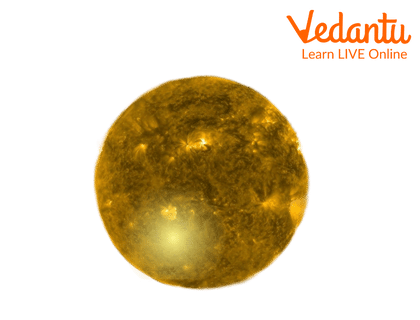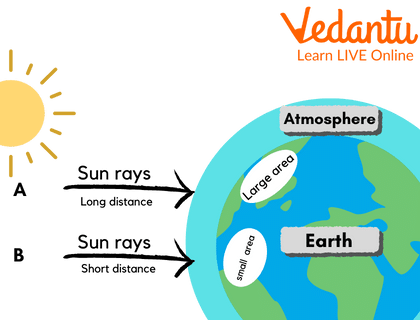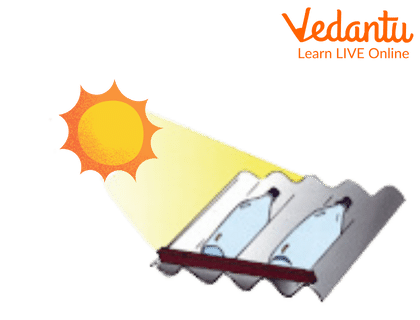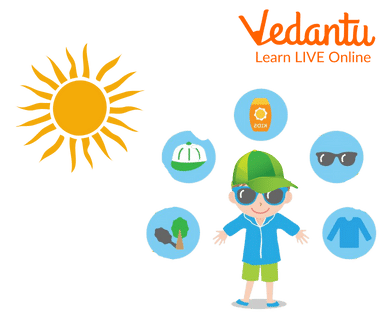




What is Sunlight?
The sun is a powerful source of energy. Even though it is very far away, its energy is important to the earth. Sunlight is the light that is produced by the sun. Sunlight is a source of energy in all ecosystems. The amount of sunlight depends on the time of the day and cloud cover.

The Sun is A Powerful Source of Sunlight
Source of Sunlight
Sunlight is the light that comes from the sun. Sunshine is a combination of bright light and heat in the form of waves. This is also called solar radiation. It takes 8.3 minutes to reach earth from the surface of the sun. Sunlight is filtered and broken up by the earth's atmosphere. 16% of the solar radiation is absorbed by the atmosphere, 6% is broken down in space, 28% is reflected by the clouds, and about only 47% of the total solar radiation reaches the earth's surface.

The Sunlight is Filtered Through the Earth's Atmosphere.
Sunlight is Made of Three Major Portions:
Visible light
Ultraviolet light (UV light)
Infrared radiation
Types of Sunlight

Sunlight in the Electromagnetic Spectrum.
Sunlight is Broken Into Three Components:
Visible Light - with wavelengths (distance between two points of two continuous waves) between 0.4 and 0.8 micrometres, constitutes nearly half of the total radiation received at the surface of the earth.
Ultraviolet Light - with wavelengths shorter than 0.8 mm, constitutes only a small proportion of the total radiation but is very important. It produces Vitamin D.
Infrared Radiation - with wavelengths longer than 0.8 mm, this portion has a heat-producing quality.
Uses of Sunlight
Sunlight is used for solar disinfection. This process kills bacteria and viruses in water.

Solar Disinfection
Solar cells or photovoltaics convert sunlight directly into electricity.
Plants use sunlight to make their food. They convert sunlight into chemical energy. This process is called photosynthesis. As a result of the sunlight that they absorb, plants are also filled with Vitamin D which is important for animals.

Plants Need Sunlight for Photosynthesis.
Sunlight on the skin produces Vitamin D, which is important for strong bones.
Effects of Sunlight
Insufficient sunlight affects the process of photosynthesis. If plants get very little sunlight, they will not have as much glucose or energy stored in it and will not survive for long.
Insufficient sunlight in animals can cause Vitamin D deficiency, leading to weak and brittle bones. Vitamin D is important for strong bones and a good immune system.
Too much is also harmful to the skin. The sunlight also has UV radiation which can penetrate the skin and damage the cell DNA. This can cause skin cancer. This can be prevented by using sunscreen before going into the sun.
Sunlight can be too bright, and looking directly at the sun can damage a person's vision. Sunglasses, hats, etc., can be used to prevent this.

Direct Sunlight Should Be Avoided.
Solved Questions
1. Which portion of sunlight has a heat-producing quality?
Ans: Infrared radiation has a heat-producing quality.
2. How is insufficient sunlight harmful to plants?
Ans: Insufficient sunlight can affect the process of photosynthesis. If plants get very little sunlight, they will not have as much glucose or energy stored in it and will not survive for long.
Practice Questions
Choose the correct answer.
1. Too much sunlight can cause skin damage.
True
False
2. Which portion of light has a wavelength less than 0.4mm?
UV light
Visible light
Infrared radiation.
None of the above.
Learning By Doing
Fun Activity:
Take 2 pots and add soil to them. Name them A and B. Add some gram seed to both pots. Keep pot A in the sunlight and keep pot B inside the house and cover it with a cardboard box. Water both pots every day. After a few weeks see the results. You will notice that only one pot will have grown green leaves. This is because plants need sunlight to grow. Try it!
Summary
The light of the Sun is the primary source of energy in all ecosystems. Sunlight affects the survival of all organisms on Earth. All organisms on earth depend on acquiring the right amount of sunlight for energy and nourishment. Too much sunlight or too little sunlight can affect their health in different ways.
FAQs on Sunlight- The Source of Life
1. Why is the Sun called the ultimate source of life on Earth?
The Sun is called the ultimate source of life because nearly all living things depend on it for energy. Plants use sunlight to make their food through a process called photosynthesis. Animals and humans get their energy by eating these plants or by eating other animals that have eaten plants. Therefore, the energy for almost all life originates from the Sun.
2. What are the main ways sunlight helps us on Earth?
Sunlight is essential for many reasons beyond just providing light. Its main benefits include:
- Heat: It keeps our planet warm enough for life to survive.
- Energy for Plants: It powers photosynthesis, which is the foundation of most food chains.
- Vitamin D: Sunlight helps our bodies produce Vitamin D, which is crucial for healthy bones.
- The Water Cycle: The Sun's heat evaporates water from oceans and lakes, which later falls as rain, providing fresh water.
3. Is sunlight really white in colour?
Sunlight appears white to our eyes, but it is actually a mixture of seven different colours, just like a rainbow. These colours are Violet, Indigo, Blue, Green, Yellow, Orange, and Red (VIBGYOR). When all these colours are combined, they create what we perceive as white light.
4. How does sunlight create shadows?
Sunlight travels in straight lines. When an opaque object, such as a person or a tree, blocks the path of this light, it creates a dark area on the other side. This dark area, where the light cannot reach, is called a shadow. The shape of the shadow usually resembles the object that is blocking the sunlight.
5. If the Sun gives life, does that mean the Sun itself is a living thing?
That is an excellent question. While the Sun is vital for life, it is not a living thing itself. The Sun is a giant star made of extremely hot gases that produce energy through a process called nuclear fusion. Unlike living organisms, the Sun does not grow, breathe, reproduce, or respond to its environment in the way that plants and animals do.
6. Why do some parts of the Earth receive more sunlight than others?
The amount of sunlight a place gets depends on the Earth's curve and its tilt.
- The Equator, which is the imaginary line around the middle of the Earth, receives the most direct and concentrated sunlight throughout the year. This makes these regions the warmest.
- The North and South Poles, at the top and bottom of the Earth, receive sunlight at a very low angle. The light is more spread out and less intense, which is why these areas are the coldest.
7. What would happen to life on Earth if there were no sunlight?
Without sunlight, life as we know it would not be possible. The Earth would quickly become a dark and extremely cold planet. Plants would be unable to perform photosynthesis and would die out. This would cause the entire food chain to collapse, as there would be no food for plant-eating animals, and subsequently, no food for meat-eating animals. The water cycle would also stop, turning Earth into a frozen, barren world.





















